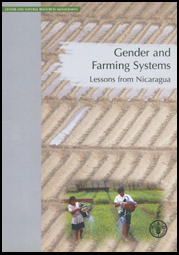
Gender and farming systems
Lessons from Nicaragua
Food and Agriculture Organization of the United Nations
Rome, 2005
 |
GENDER AND NATURAL RESOURCES MANAGEMENT
Gender and farming systems |
|
Food and Agriculture Organization of the United Nations Rome, 2005 |
|
The Food and Agriculture Organization of the United Nations is the specialized agency responsible for agriculture, forestry and fishery worldwide. FAO has the mandate to promote sustainable agriculture and rural development, as well as food security, for the whole population. It extends the mission to assure that women - together with men - have access to necessary resources and receive support to obtain sustainable means of sustenance and improved life quality.
First edition 1997
Second edition 2005
|
The designations employed and the presentation of material in this information product do not imply the expression of any opinion whatsoever on the part of the Food and Agriculture Organization of the United Nations concerning the legal or development status of any country, territory, city or area or of its authorities, or concerning the delimitation of its frontiers or boundaries. |
Research
Frederic Devé, consultant: compilation and analysis of the project information GCP/NIC/020/NOR.
National Technical Team of the project: methodological base of the Nicaraguan's project field work
Felipe Martínez Sánchez, consultant of the project: "Propuesta metodológica de diagnóstico con enfoque de género en los sistemas de producción agropecuarios (1997)" (methodological proposal on gender analysis in farming systems)
Coordination and guidelines
Zoraida García, Programme Officer, Gender and Development Service Gender and Population Division of the FAO
All rights reserved. Reproduction and dissemination of material in this information
product for educational or other non-commercial purposes are authorized without
any prior written permission from the copyright holders provided the source
is fully acknowledged. Reproduction of material in this information product
for resale or other commercial purposes is prohibited without written permission
of the copyright holders.
Applications for such permission should be addressed to:
Chief
Publishing Management Service Information Division
FAO
Viale delle Terme di Caracalla, 00100 Rome, Italy
or by e-mail to: [email protected]
© FAO 2005
I. Gender and systems approach: main considerations
1.1 Introduction: agriculture, gender and appraisals
Transformations in agriculture and appraisals
Transformations in gender roles and appraisals1.2.1 Background to the basic theory of systemic analysis
1.2.2 Basic concepts of systemic analysis applied to agriculture
1.2.3 Key aspects of systemic analysis applied to agriculture1.3 The importance of gender as an analytical category
1.3.1 Historical background
1.3.2 Concepts and gender roles
1.3.3 Gender analysis
1.3.4 Key aspects of gender analysis applied to agriculture
II. The Nicaraguan experience: presentation and lessons learned
2.1 Introduction
2.2 Appraisals and surveys conducted at the municipality level2.2.1 The Rio Blanco/Bocana de Paiwas appraisal
2.2.2 Review of Terrabona's farming and agrarian systems
2.2.3 Characterization of the municipality of San Ramón2.3 Systemic and gender analysis at the community level
2.4 Introduction of innovations
2.5 Some conclusions
3.1 Rapid agricultural and socio-economic survey at the microregional or municipality level
3.1.1 Methodological steps and main variables
Zoning
General status of women in the municipality
Historical trends3.1.2 Methodological guidelines and tools
Collecting baseline data and map-making
Field visits
Interviews with key informants
Presenting the results and feedback from local bodies3.2 Systemic and gender analysis at the community level
3.2.1 Methodological steps, main variables, guidelines and tools
Establishing contact with the community and the contact persons and forming a local work team
Baseline agrosocio-economic data on the community ("learning about our community")
Social and gender characterization of the families in the community ("getting to know each other")
Characterization of the organizations present in the community ("our organizations")
Analysis of farming systems
Community problems and plan of action